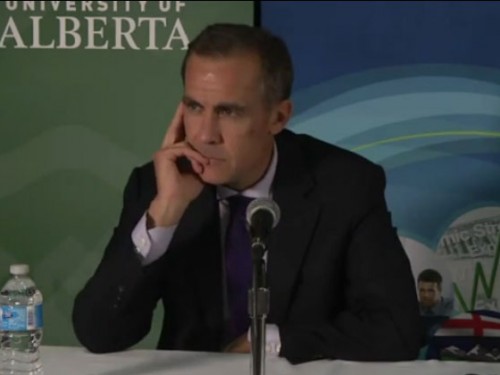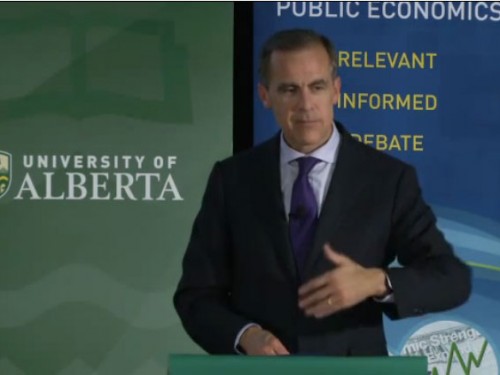Financial Crisis Taught Important Lessons About Monetary Policy, says Bank of Canada Governor Mark Carney
While countries around the world continue to cope with the painful aftermath of the global financial crisis, the scope and fury of events have left policy-makers with important lessons about the functioning of monetary policy and its frameworks, instruments and tactics, Bank of Canada Governor Mark Carney said today in a wide-ranging lecture about monetary policy “after the fall.”
As the third Bank of Canada Governor to deliver the Eric J. Hanson Memorial Lecture, Governor Carney cited previous Hanson Lectures by Governors John Crow, in 1988, and David Dodge, in 2008, as important works that had laid out the Bank’s perspective regarding the evolution of monetary policy prior to the crisis, including its firm, ongoing commitment to price stability.
Today, in the wake of the global financial crisis, “fundamental questions are being asked about monetary policy, its scope, and the roles and responsibilities of central banks,” Governor Carney said.
“Globally, central banks are now being simultaneously accused of being ineffective and too powerful. The goals of monetary policy are being called into question,” the Governor stated. “It is also being recognised that how monetary policy interacts with other macro policies, including fiscal and macroprudential policies, can affect its independence and potentially its effectiveness.”
Governor Carney noted that price stability remains the paramount objective of monetary policy. While the experience of the crisis demonstrated the essential value of flexible inflation targeting as the dominant monetary policy framework, events suggested some core lessons that could influence its form and conduct.
First, price stability does not guarantee financial stability. Price stability can be associated with excessive credit growth and emerging asset bubbles, which can ultimately compromise the achievement of price stability. Further, stability can encourage excessive optimism that can lead to overestimates of future growth in incomes and asset prices, creating for a time a self-reinforcing asset and credit boom. “Eventually,” Governor Carney said, “the future is now and reality reasserts.”
Second, monetary policy is the last line of defence against financial vulnerabilities. The first lines of defence (responsible behaviour by individuals and institutions and micro- and macroprudential regulation and supervision) will go a long way to mitigate the risk of financial excesses. On the margin, monetary policy should be complementary to macroprudential efforts that have already been instituted. Whether it should actively lean depends on the severity of the imbalances and how effective the macroprudential measures are expected to be. In exceptional cases, monetary policy may be needed to support financial stability.
Third, central banks are not powerless at the zero lower bound. With the onset of the crisis, the zero lower bound went from remote possibility to reality with frightening speed. This led central banks to quickly develop unconventional measures to provide stimulus, including credit easing, quantitative easing and extraordinary forward guidance. “As with any policy action, the effectiveness of unconventional policies requires that they remain credible and consistent with well-anchored inflation expectations,” Governor Carney said.
Fourth, communications matter. In April 2009, the Bank committed to hold rates at the zero lower bound, conditional on the outlook for inflation, through the second quarter of 2010. “Our conditional commitment worked because it was exceptional, explicit and anchored in a highly credible inflation-targeting framework,” Governor Carney said. By increasing the expected duration of rates at the lower bound, guidance can lead to lower long-term nominal rates. The increased certainty regarding the path of rates reinforces this stimulative effect. “By outlining (and bounding) the consequences of its strategy for near-term inflation dynamics,” noted Governor Carney, “the central bank can help anchor inflation expectations and retain credibility.”
Fifth, the limits of central banks’ discretionary authority need to be clarified. The time frame for returning inflation to target can be extended, but the credibility essential for the success of such a tactic could be undermined if such flexibility is taken too far, deployed too frequently or undertaken by stealth. Further, the flexibility that central banks may require, both to address the consequences of the crisis and to reduce the risk of a repeat, raises a fundamental question about the appropriate constraints on central banks’ delegated authority. “Making operational a more flexible role for monetary policy requires clear frameworks,” Governor Carney said, adding that a clear framework enhances the accountability of the central bank and the effectiveness of its monetary policy. “It is critical to have a clear framework. The better this framework is understood by the public, the greater the chance of success.”
In concluding, the Governor noted that the fallout from the crisis has increased the demands on monetary policy and has stretched the flexibility of inflation-targeting frameworks. “It has been a fascinating, sometimes harrowing, five years since Governor Dodge’s Hanson Lecture,” Governor Carney said. “While the crisis left us with many lessons, we still have much to learn.”


